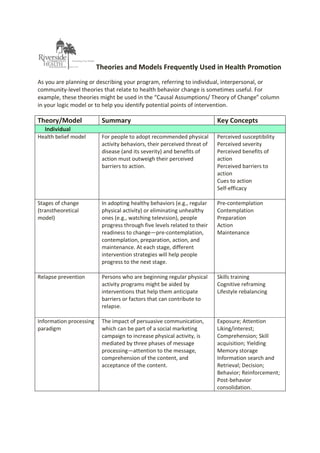
Theories and Models for Health Promotion Programs
- 1. Theories and Models Frequently Used in Health Promotion As you are planning or describing your program, referring to individual, interpersonal, or community-level theories that relate to health behavior change is sometimes useful. For example, these theories might be used in the “Causal Assumptions/ Theory of Change” column in your logic model or to help you identify potential points of intervention. Theory/Model Summary Key Concepts Individual Health belief model For people to adopt recommended physical activity behaviors, their perceived threat of disease (and its severity) and benefits of action must outweigh their perceived barriers to action. Perceived susceptibility Perceived severity Perceived benefits of action Perceived barriers to action Cues to action Self-efficacy Stages of change (transtheoretical model) In adopting healthy behaviors (e.g., regular physical activity) or eliminating unhealthy ones (e.g., watching television), people progress through five levels related to their readiness to change—pre-contemplation, contemplation, preparation, action, and maintenance. At each stage, different intervention strategies will help people progress to the next stage. Pre-contemplation Contemplation Preparation Action Maintenance Relapse prevention Persons who are beginning regular physical activity programs might be aided by interventions that help them anticipate barriers or factors that can contribute to relapse. Skills training Cognitive reframing Lifestyle rebalancing Information processing paradigm The impact of persuasive communication, which can be part of a social marketing campaign to increase physical activity, is mediated by three phases of message processing—attention to the message, comprehension of the content, and acceptance of the content. Exposure; Attention Liking/interest; Comprehension; Skill acquisition; Yielding Memory storage Information search and Retrieval; Decision; Behavior; Reinforcement; Post-behavior consolidation.
- 2. Theories and Models Frequently Used in Health Promotion Theory/Model Summary Key Concepts Interpersonal Level Social learning/ social cognitive theory Health behavioral change is the result of reciprocal relationships among the environment, personal factors, and attributes of the behavior itself. Self-efficacy is one of the most important characteristics that determine behavioral change. Self-efficacy Reciprocal determinism Behavioral capability Outcome expectations Observational learning Theory of reasoned action For behaviors that are within a person’s control, behavioral intentions predict actual behavior. Intentions are determined by two factors—attitude toward the behavior and beliefs regarding others people’s support of the behavior. Attitude toward the behavior • Outcome expectations • Value of outcome expectations Subjective norms • Beliefs of others • Desire to comply with others Theory of planned behavior People’s perceived control over the opportunities, resources, and skills needed to perform a behavior affect behavioral intentions, as do the two factors in the theory of reasoned action. Attitude toward the behavior • Outcome expectations • Value of outcome expectations Subjective norms • Beliefs of others • Desire to comply with others Perceived behavioral control Social Support Often incorporated into health promotion interventions, social support can be instrumental, informational, emotional, or appraising (providing feedback and reinforcement of new behavior) Instrumental support Informational support Emotional support Appraisal support Individual Level
- 3. Theories and Models Frequently Used in Health Promotion Theory/Model Summary Key Concepts Community Level Community organization model Public health workers help communities identify health and social problems, and they plan and implement strategies to address these problems. Active community participation is essential. Social planning Locality development Social action Ecological approaches Effective interventions must influence multiple levels because health is shaped by many environmental subsystems, including family, community, workplace, beliefs and traditions, economics, and the physical and social environments. Multiple levels of influence • Intrapersonal • Interpersonal • Institutional • Community • Public policy Organizational change theory Certain processes and strategies might increase the chances that healthy policies and programs will be adopted and maintained in formal organizations. Definition of problem (awareness stage) Initiation of action (adoption stage) Implementation of change Institutionalization of change Diffusion of innovations theory People, organizations, or societies adopt new ideas, products, or behaviors at different rates, and the rate of adoption is affected by some predictable factors. Relative advantage Compatibility Complexity Trialability Observability Sources: 1. Alcalay R, Bell RA. Promoting Nutrition and Physical Activity Through Social Marketing: Current Practices and Recommendations. Davis, CA: Center for Advanced Studies in Nutrition and Social Marketing, University of California, Davis; 2000. 2. National Institutes of Health. Theory at a Glance: A Guide for Health Promotion Practice. Bethesda, MD: National Institutes of Health, National Cancer Institute; 1995. 3. US Department of Health and Human Services. Physical Activity and Health: A Report of the Surgeon General. Atlanta, GA: US Department of Health and Human Services, Centers for Disease Control and Prevention, National Center for Chronic Disease Prevention and Health Promotion. This table adapted from: US Department of Health and Human Services. Physical Activity Evaluation Handbook. Atlanta, GA: US Department of Health and Human Services, Centers for Disease Control and Prevention; 2002, Appendix 3, pg. 43. (http://www.cdc.gov/nccdphp/dnpa/physical/handbook/pdf/handbook.pdf)